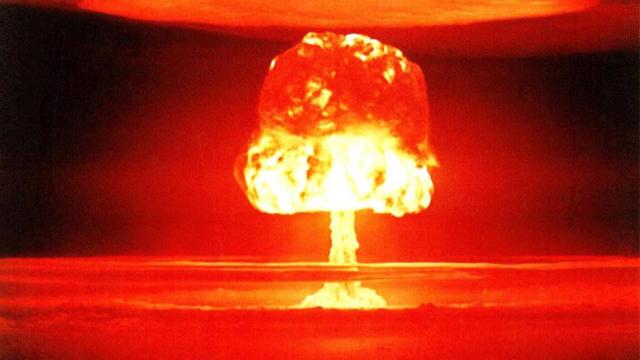You rarely — if ever — hear “South Africa” and “nuclear weapons” mentioned in the same breath. That’s, of course, because South Africa doesn’t have any nukes. But the history behind why it is the only country to have ever built its own nuclear weapons, and then voluntarily relinquished them, reveals what motivates a country to give up the world’s most lethal deterrent.
An American nuclear bomb test in 1954.
It’s sort of an interesting question right now, as the global community has been trying to get North Korea to give up its own nuclear weapons for years. Seeing as how the capital of South Korea, Seoul, is easily within range of even North Korea’s relatively primitive potential nuclear missile delivery systems, getting the North to somehow voluntarily give up its nukes seems to be the only viable option.
South Africa built six gun-type nuclear weapons in the early 1980s, and had begun construction on a seventh. Gun-type devices are the simplest form of nuclear weapon, and one was used as the bomb that destroyed Hiroshima at the end of World War II. It’s based on one of the simplest nuke design principles, which is that if you slam two smaller pieces of Uranium-235 into each other, at high enough speed, it will explode.
A lot.
During the height of the Cold War, Russia and the United States were the two competing foes, but South Africa also feared a Kremlin attack. Pretoria did not believe its neighbours posed a major military threat, however its leadership was concerned about the international community’s growing criticism of its apartheid government. What really concerned the apartheid leadership was the Moscow-backed Cuban military intervention in Angola. Officials also feared a possible Soviet-backed invasion of South Africa by Namibian forces, making the possession of nuclear weapons necessary.
Pretoria came up with a multi-stage nuclear deterrence strategy, as explained by the Nuclear Threat Initiative:
The first stage called for South Africa to keep its nuclear capabilities secret or ambiguous in the absence of hostilities. If the invasion threat elevated, Pretoria would initiate a second stage, confidently indicating its nuclear deterrent capability to one or more of the major powers — such as the United States — in an effort to persuade them to intervene. If this proved unsuccessful, South Africa would publicly declare its nuclear capability. The third stage of the strategy also included, if necessary, a nuclear detonation in an underground or open ocean test to demonstrate the capability. As a last resort, South Africa would threaten the battlefield use of nuclear weapons.
But South Africa never did engage in any full-scale nuclear tests. And F.W. de Klerk, the last president of apartheid-era South Africa, wrote in the Los Angeles Times in 2013 that they never desired to use them:
The strategy was that if the situation in southern Africa were ever to seriously deteriorate, one or more of the major powers would be told of the bombs’ existence in an attempt to persuade those nations to intervene. There was never any intention to use the devices, which were regarded purely as a deterrent.
What made the South Africans give them up, as NPR reporter Greg Myre, who toured one of South Africa’s nuclear facilities wrote recently, was the fall of the Soviet Union and the release of Nelson Mandela in 1990, the world’s most well-known political prisoner and most polarising figure at the time. With the USSR gone and the release of Mandela, a major military threat was gone and the world no longer had a reason to isolate Pretoria.
A year later, de Klerk ditched the nation’s nuclear weapons program and signed on to the the Nuclear Nonproliferation Treaty in 1991; he made the announcement in 1993.
What was key for the South Africans to give up their weapons was the elimination of its primary threat: the USSR. To put this in context, world leaders are struggling to come up with ways to get North Korea to relinquish its nukes. Nothing has worked over the past twenty-plus years. Negotiations, military threats, sanctions, nothing. Washington has recently called for military strikes against Pyongyang, which certainly isn’t the best way to ask them to give up their nuclear weapons.
And then you have the case of Ukraine. It gave up its nukes based on the 1994 Budapest Memorandums on Security Assurances, which, in writing, assured Ukraine that Western powers would protect its sovereignty in exchange. Of course, Russian troops are in eastern Ukraine and annexed Crimea, so that document was nothing more than a piece of toilet paper. Given that history, nations with nuclear weapons will be less inclined to give them up.
South Africa’s move to give up its nuclear weapons wasn’t simply an act of good will. The apartheid government made shrewd calculations of their surrounding military threats, the benefits of non-proliferation and a roadmap to being a nuclear free nation. Had the USSR not fallen and no one cared that Mandela was imprisoned or not, South Africa could have very well been a nuclear state beyond 1991.
But fortunately, the Cold War ended and that triggered Pretoria to give up its nukes, making the continent of Africa and the world a much safer place.
